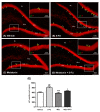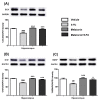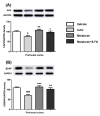Melatonin Protects against the Side-Effects of 5-Fluorouracil on Hippocampal Neurogenesis and Ameliorates Antioxidant Activity in an Adult Rat Hippocampus and Prefrontal Cortex
- PMID: 33923672
- PMCID: PMC8074234
- DOI: 10.3390/antiox10040615
Melatonin Protects against the Side-Effects of 5-Fluorouracil on Hippocampal Neurogenesis and Ameliorates Antioxidant Activity in an Adult Rat Hippocampus and Prefrontal Cortex
Abstract
Melatonin is an endogenous hormone that exhibits antioxidant functions and neuroprotective effects. The hippocampus and the prefrontal cortex (PFC) play an important role linked to working memory. 5-fluorouracil (5-FU) can induce oxidative stress and reduce neurogenesis in the subgranular zone (SGZ) of the dentate gyrus in a rat hippocampus and these alterations are related to working memory deficits. This study aimed to determine the effect of melatonin on 5-FU-induced oxidative stress that interferes with the antioxidant enzymes and protein expression levels in a rat hippocampus and PFC. A total of 68 male Sprague Dawley rats were divided into four groups: vehicle, 5-FU, melatonin and melatonin+5-FU groups. Rats were administered 5-FU (25 mg/kg, i.v.) on days 9, 12, 15, 18 and 21 and received melatonin (8 mg/kg, i.p.) at 19:00 from day 1 to day 21 of the experiment. Lipid peroxidation was assessed by measuring malondialdehyde (MDA) levels. Antioxidant enzyme levels including glutathione peroxidase (GPX), catalase (CAT) and superoxide dismutase (SOD) were determined. p21 immunofluorescence staining and Western blotting were used to detect the cell cycle arrest and protein expression of the nuclear factor erythroid 2-related factor 2 (Nrf2), doublecortin (DCX) and brain derived neurotrophic factor (BDNF), respectively. The results showed that melatonin reduced the number of p21-positive cells in the SGZ of the dentate gyrus and increased Nrf2, DCX and BDNF protein expression in rats treated with 5-FU. Moreover, melatonin restored antioxidant enzyme levels and reduced oxidative stress in the hippocampus and PFC caused by 5-FU. These findings reveal a mechanism of the neuroprotective properties of melatonin against 5-FU in a rat hippocampus and PFC.
Keywords: 5-fluorouracil; antioxidant enzymes; hippocampus; melatonin; neurogenesis; oxidative stress; prefrontal cortex; rat.
Conflict of interest statement
The authors declare no conflict of interests.
Figures






Similar articles
-
Melatonin Attenuates Methotrexate-Induced Reduction of Antioxidant Activity Related to Decreases of Neurogenesis in Adult Rat Hippocampus and Prefrontal Cortex.Oxid Med Cell Longev. 2022 Jul 15;2022:1596362. doi: 10.1155/2022/1596362. eCollection 2022. Oxid Med Cell Longev. 2022. PMID: 35873801 Free PMC article.
-
Melatonin Ameliorates Valproic Acid-Induced Neurogenesis Impairment: The Role of Oxidative Stress in Adult Rats.Oxid Med Cell Longev. 2021 Nov 12;2021:9997582. doi: 10.1155/2021/9997582. eCollection 2021. Oxid Med Cell Longev. 2021. PMID: 34804374 Free PMC article.
-
Neuroprotective Properties of Asiatic Acid against 5-Fluorouracil Chemotherapy in the Hippocampus in an Adult Rat Model.Nutrients. 2018 Aug 9;10(8):1053. doi: 10.3390/nu10081053. Nutrients. 2018. PMID: 30096914 Free PMC article.
-
Melatonin attenuates 5-fluorouracil-induced spatial memory and hippocampal neurogenesis impairment in adult rats.Life Sci. 2020 May 1;248:117468. doi: 10.1016/j.lfs.2020.117468. Epub 2020 Feb 25. Life Sci. 2020. PMID: 32105705
-
Antioxidant Actions of Melatonin: A Systematic Review of Animal Studies.Antioxidants (Basel). 2024 Apr 7;13(4):439. doi: 10.3390/antiox13040439. Antioxidants (Basel). 2024. PMID: 38671887 Free PMC article. Review.
Cited by
-
Baicalin Ameliorates Corticosterone-Induced Depression by Promoting Neurodevelopment of Hippocampal via mTOR/GSK3β Pathway.Chin J Integr Med. 2023 May;29(5):405-412. doi: 10.1007/s11655-022-3590-z. Epub 2023 Jan 6. Chin J Integr Med. 2023. PMID: 36607586
-
Oxidative Stress in Neurodegenerative Diseases.Antioxidants (Basel). 2022 Mar 5;11(3):504. doi: 10.3390/antiox11030504. Antioxidants (Basel). 2022. PMID: 35326154 Free PMC article.
-
Celastrol and Melatonin Modify SIRT1, SIRT6 and SIRT7 Gene Expression and Improve the Response of Human Granulosa-Lutein Cells to Oxidative Stress.Antioxidants (Basel). 2021 Nov 24;10(12):1871. doi: 10.3390/antiox10121871. Antioxidants (Basel). 2021. PMID: 34942974 Free PMC article.
-
Synergistic eradicating impact of 5-fluouracil with FeO nanoparticles-diethyldithiocarbamate in colon cancer spheroids.Nanomedicine (Lond). 2024;19(11):979-994. doi: 10.2217/nnm-2024-0007. Epub 2024 Apr 5. Nanomedicine (Lond). 2024. PMID: 38578787 Free PMC article.
-
Ketogenic diet prevents chronic sleep deprivation-induced Alzheimer's disease by inhibiting iron dyshomeostasis and promoting repair via Sirt1/Nrf2 pathway.Front Aging Neurosci. 2022 Sep 1;14:998292. doi: 10.3389/fnagi.2022.998292. eCollection 2022. Front Aging Neurosci. 2022. PMID: 36118706 Free PMC article.
References
Grants and funding
LinkOut - more resources
Full Text Sources
Other Literature Sources
Miscellaneous

